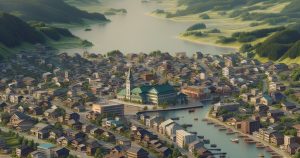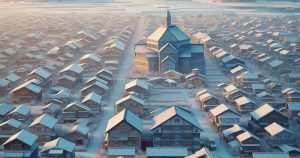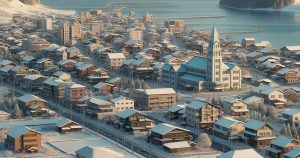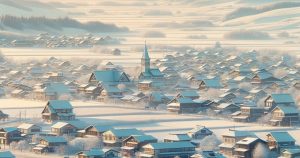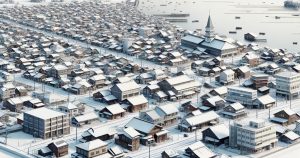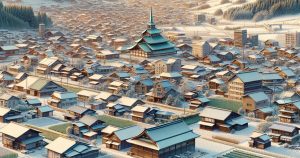| population | 2,185 peoples |
|---|---|
| area | 81.64 km² |
| population density | 26.8 peoples/km² |
Rebun Town, located at the northernmost tip of Japan, is a beautiful and remote island community floating in the Sea of Japan. Known as the “Floating Island of Flowers,” the entire area of Rebun Island belongs to the town, which is part of the Soya Subprefecture in Hokkaido. It lies about 60 km west of Wakkanai City. Deeply influenced by Ainu culture, the island retains a strong sense of harmony between people and nature. Since the Showa period, the town has developed around its twin economic pillars of fishing and tourism, offering visitors a unique blend of rich seafood, wild landscapes, and warm island hospitality. Locals live in rhythm with the sea and the seasons, inheriting traditional Ainu customs and expressions of gratitude toward nature through festivals and rituals. Summer brings the bountiful harvest of sea urchins and fish, while in winter the sea ice drifts close to the shore, creating awe-inspiring scenery at Japan’s northern edge.
Culture and Traditions
Rebun Town represents a distinctive cultural area where Ainu traditions and the pioneering spirit of the Showa era coexist. Residents live in close harmony with the sea, the flowers, and the land, practicing a way of life shaped by the island’s natural rhythm.
The town’s major industries are fishing and tourism. During summer, sea urchin harvesting peaks, and the local delicacy “Uni-don” (sea urchin rice bowl) attracts gourmets from across Japan. The local dialect still carries traces of both Hokkaido regional speech and Ainu vocabulary, symbolizing the coexistence of two rich cultural heritages.
Annual festivals such as the Flower Festival in June and the Strait Festival in August express gratitude for the blessings of nature. These events strengthen community bonds and allow visitors to experience Rebun’s culture firsthand. Facilities dedicated to Ainu culture and the conservation of alpine flora help preserve the island’s unique traditions.
From spring through autumn, over 300 species of alpine plants bloom across the island, earning Rebun its nickname as the “Island of Flowers.” The Rebun Alpine Botanical Garden and the Momoiwa Observation Deck offer breathtaking views of this colorful landscape. In winter, drifting sea ice and brilliant night skies make the island equally captivating.
Local Specialties
- Ezo Bafun Uni (Sea Urchin): Harvested from the cold, clear waters surrounding Rebun Island between June and August. Famous for its creamy sweetness, it is best enjoyed fresh in a local “Uni-don” at restaurants near Kafuka Port.
- Rishiri Kombu (Kelp): Along with neighboring Rishiri Island, Rebun produces one of Japan’s highest-quality kelps. Its refined umami makes it prized by chefs nationwide.
- Hokke, Flounder, and Octopus: The island’s fisheries operate year-round. Dried Atka mackerel (“Rebun Hokke”) and grilled seafood are signature local dishes enjoyed by both residents and visitors.
- Hotate Burger (Scallop Burger): A popular local gourmet item featuring fried scallops and homemade tartar sauce between soft buns—highly recommended for travelers.
- Rebun Beer: A craft beer brewed with pure island water. Its crisp and refreshing flavor pairs perfectly with Rebun’s seafood cuisine.
Annual Events
- Flower Festival (June): Rebun’s largest event celebrating the island’s alpine flowers. The blooming of the rare Rebun Atsumoriso orchid attracts photographers and botanists from around the world. Main venue: Rebun Alpine Botanical Garden.
- Lake Festival (August): Held around Lake Kushu, Japan’s northernmost lake. Features fireworks, local food stalls, and stage performances in a vibrant summer atmosphere.
- Strait Festival (August): A traditional event praying for safety at sea and a good fishing season. Highlights include portable shrines carried through town and colorful fishing-boat parades.
- Winter Star-Watching Night (January–February): During the long northern nights, stargazing events are held at Cape Sukoton and the Kafuka area. Visitors can marvel at one of Japan’s clearest winter skies.
Access
- By Air: The nearest airport is Wakkanai Airport. From there, take a bus (about 30 minutes) to Wakkanai Port for ferry connections to Rebun Island.
- By Ferry: The Wakkanai Port–Kafuka Port route, operated by Heart Land Ferry, takes about two hours. Seasonal routes via Rishiri Island are also available.
- By Bus: Within the island, Soya Bus runs between Kafuka, Funadomari, and Cape Sukoton, providing access to key tourist areas.
- By Car: Rental cars and taxis are available near Kafuka Port. The main island road, Hokkaido Route 40 (Rebun Island Line), runs north–south through the town.
- By Bicycle: From late spring to early autumn, cycling is a popular way to explore the island. Rental bicycles are available around Kafuka, allowing travelers to enjoy the sea breeze and open landscapes.
Tourist Attractions
- Rebun Onsen Usuyuki-no-Yu – A seaside hot spring with open-air baths overlooking the ocean; perfect for relaxing after hiking or sightseeing.
- Cape Sukoton – The northernmost tip of Rebun Island and the entire Japanese archipelago (excluding disputed territories). On clear days, Sakhalin can be seen across the sea.
- Cape Sukai – A breathtaking cliff with turquoise waters below. Featured in the film “Kita no Kanaria-tachi” (2012).
- Momoiwa Observation Deck – Offers a panoramic view of Rebun’s southern coastline and alpine flower fields. A key stop on the island’s “8-Hour Romantic Hiking Course.”
- Lake Kushu – Japan’s northernmost lake, home to water lilies, skunk cabbages, and migratory birds. In winter, the frozen lake becomes a serene snowscape.


